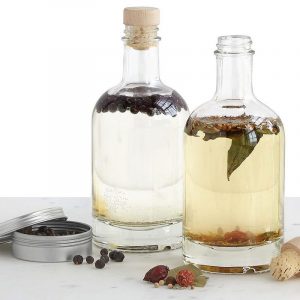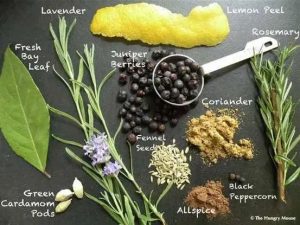Making gin (by Guy Palmer)
Guy Palmer, from Eltham, is this website’s webmaster and occasional author of food and drink articles for this website.
Introduction
A few years ago, I was lucky enough to attend a workshop at Sustainable Macleod where Gabrielle Callahan showed us how to make gin. It was a revelation: gin is really easy, really fun and really quick to make at home!
Most spirits are defined by the source of their alcohol. Brandy is made from fermented grapes. Rum is made from fermented sugarcane. Whisky is made from fermented grain. Vodka is made from fermented potatoes (or fermented grain). But gin is an exception because it can be made with any neutral spirit. Whilst commercial gin makers usually use spirit bought from industrial ethanol factories, home gin makers usually use vodka.
 Rather than the alcohol, the thing that defines gin is the presence of juniper berries.
Rather than the alcohol, the thing that defines gin is the presence of juniper berries.
Nowadays, all gins contain ‘botanicals’ to give them flavour but basically any seed, berry, root, fruit or herb can count as a ‘botanical’. In concept, therefore, you can add just about whatever you want to give the gin flavour.
Finally, whilst commercial gins are usually made by distillation, homemade gin is simply made by adding the ingredients together and waiting.
So, the recipe for gin is really simple. Ingredients: vodka, juniper berries and ‘botanicals’. Method: mix all the ingredients together and, after a few days, sieve.
And the fun part of making gin is that you can experiment with different botanicals and thus different flavours. Every bottle that you make will taste a bit different.
 The two most commonly used botanicals are coriander seed and citrus peel (e.g. lemon or orange). Other often used botanicals include cardamom pods, nutmeg, angelica root and orris root. Wikipedia also lists anise, liquorice root, cinnamon, almond, cubeb, savory, dragon eye (longan), saffron, baobab, frankincense, coriander, grains of paradise and cassia bark as possibilities. Or, if you have them, you could include lavender, chamomile, rose, rosemary or sage.
The two most commonly used botanicals are coriander seed and citrus peel (e.g. lemon or orange). Other often used botanicals include cardamom pods, nutmeg, angelica root and orris root. Wikipedia also lists anise, liquorice root, cinnamon, almond, cubeb, savory, dragon eye (longan), saffron, baobab, frankincense, coriander, grains of paradise and cassia bark as possibilities. Or, if you have them, you could include lavender, chamomile, rose, rosemary or sage.
When I gave a draft of this article to Gabrielle to comment on, she pointed out that homemade gin sometimes picks up some of the colours from the botanicals. For those people to whom this is a problem and who have access to a still, these colours can be removed by distillation (although some of the flavour may be lost). Some commercial gin makers use colour to distinguish their brand, such as the ‘ink gin’ that uses butterfly pea flowers added after the distillation process to give the gin a bright blue colour. In response to Gabrielle’s comment, I bought a bottle of ink gin and it is indeed bright blue. But, if you squeeze some lemon juice in it (which makes it more acidic), it changes to pink! A bit like a hydrangea, only liquid and in reverse.
Finally, homemade gin is sometimes referred to as ‘bathtub gin’, which is a reference to the habit of making gin at home in the United States during prohibition.
Example ingredients
a bottle of vodka
30 grams (2 tablespoons) juniper berries
5 grams (1 teaspoon) coriander seed
1 strip of citrus peel, either fresh or dried
other botanicals to taste
Method
Mix all the ingredients together, except any fresh citrus peel, in a clean sterile bottle and leave for 24 hours.
Taste, add more botanicals if desired, add any fresh citrus peel, and leave for another 24 hours.
Taste and, if you want a stronger taste, leave for another 24 hours, shaking at least once.
Use a sieve to filter out the juniper berries and botanicals and leave for another 48 hours.
Don’t worry that if the gin is not as clear as commercial gin (that’s why they distil) but, if you feel the need, filter out any remaining sediment.
Drink!
